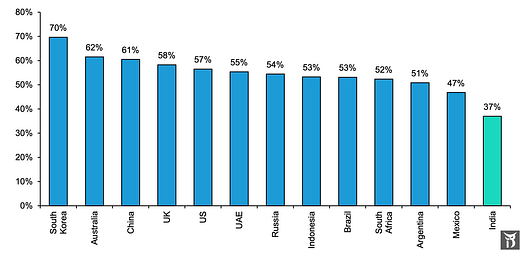India’s low female labor force participation rate of 37%* significantly constrains the country’s consumption growth potential, Bernstein analysts warned in a 150-page report examining the future of India’s middle class.
Women’s participation in India’s workforce falls well below other major economies in the G20, with Vietnam at 70% and China at 61%. This gap has remained remarkably consistent for five decades despite India’s economic transformation in other areas.
The research documents a surprising improvement over the past five years, with participation rising from 23.2% in 2017-18 to the current 37%. This progress, while notable, still leaves India substantially behind global benchmarks.
What’s remarkable is that the female workforce participation actually decreases with rising household income. In urban areas specifically, women become less likely to work as their husband’s income increases, creating a structural limitation on dual-income households.
This participation pattern directly affects consumption behaviors. The report states that lower female participation results in “higher availability of time for household work, greater perceived value for cost saving than time saving, greater emphasis on value formats versus convenience formats.”
These preferences explain why many time-saving services struggle to gain traction beyond India’s wealthiest urban centers. Households with a non-working spouse typically prioritize value over convenience, limiting demand for services like quick commerce and food delivery.
This workforce gap takes on greater importance given Bernstein’s projection that India’s middle class will expand to 500 million consumers by 2035. As the report shows, when women enter the workforce, household disposable income increases, altering both spending capacity and consumption preferences.
For India to achieve its projected economic transformation, the increasing female workforce participation trend since 2017 will need to continue and accelerate, particularly as the country approaches what Bernstein identifies as its middle-class “inflection point” later this decade.
*The 37% figure comes from World Bank, however, I should point out that many believe the number is far lower than this.



